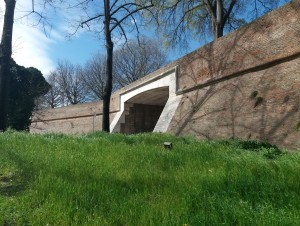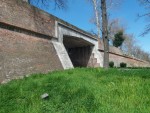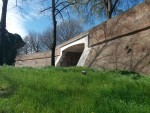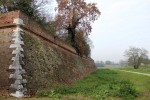Punta della Giovecca
Punta della Giovecca as we see it today is the product of one of the largest pre-WWII architectural projects involving the city walls. The intervention even sparked local and national debate and controversy.
Before the Punta della Giovecca: Canton del Follo
In 1936, the municipal authorities decided to open the two supporting archways which marked the Punta della Giovecca (Giovecca Point), the eastern semi-bastion which overlooks the imposing road of the same name, which was finished and paved in the mid-16th century. Before the new walls were built by Biagio Rossetti in the late fifteenth century (later refurbished by Alfonso I d’Este), this ‘point’ in the city walls was called the Canton del Follo, lending its name to the Via Cisterna del Follo. According to Girolamo Melchiorri, the name
originated in the fourteenth century: in this road, up until then, there was a ‘cistern’ or well that was used to wash raw wool and full fabric, e.g. press and pound felt and cloth in order to make the wool denser. The art of working with wool and turning it into cloth and fabric in Ferrara goes back to around that time. Since 1370, this craft was alive and well in Ferrara, and with Giovanni da Consandolo, with the approval of Alberto d’Este, he built, at his own expense, a ‘follo’ (fulling mill) in Borgo della Pioppia (in the part of the city called Quacchio), launching production there on 19 July 1392. The building stood near the site of the present-day Prospettiva della Giovecca, in a location once called Canton del Follo, where a tower with a door (the Portello del Follo) was visible at the point in which the wall bent at an angle, from east to north.
Demolition and controversy in the 1930s
The opening of these two passages triggered an extremely heated political and cultural debate that extended beyond the confines of the city of Ferrara. The issue under discussion was the proposal to connect the city with the new road to Tresigallo, towards the sea, thus creating a gap in the walls surrounding Ferrara. The debate ranged between those who wanted to safeguard the artistic and architectural integrity of the walls, proposing instead to direct traffic through the former Porta di San Giovanni further north, and those who were in favour of opening up the walls in line with Corso Giovecca, which would also destroy the picturesque ‘Prospettiva’ arch (designed in 1703 by Francesco Mazzarelli) and the staircase behind it. Some of the kingdom’s senators, caught up in a modernist fury, even called for the demolition of the entire system of fortifications, as was happening or had already happened in many other cities throughout Italy condemning the city walls as ‘the trappings of the past’. Writing in the columns of the Corriere Padano on 15 August 1936, Senator Vico Mantovani barked:
In this topsy-turvy world, while everywhere else, in cities of all ranks of importance, they are demolishing the bastions, entire quarters, buildings of rare artistic importance and, while in Rome, even part of the ancient walls, it remains a mystery why in Ferrara we must conserve, at all costs, a walkway that has never really constituted a public passageway in the true sense of the word, because it has never had and will never have the characteristics necessary and sufficient to that purpose, and that, over time, when it was flanked by dense trees, only served as a destination in the wee hours, when random couples wander about in search of a quiet and ... safe place!
Without letting the mind wander in search of comparisons and solutions adopted in similar circumstances, we would like to mention a case that occurred in a nearby city, that matches that of Ferrara perfectly: Via Indipendenza in Bologna, which can be an example to follow. In Bologna they demolished not only a section of the city walls, but part of a modest fortification, some remains of which can still be seen!
In Bologna, as in Rome, Florence and Milan, as in almost every city in Italy, the persistent Fascist pickaxe that sees to the needs, development and decency of the new, pulsating life of the city is fulfilling its duty: we hope it will happen in Ferrara too!
In the end, they reached a compromise, deciding that two underpasses would be opened in order to keep the walls and the staircase behind the arch intact. Among the main opponents of the ‘pickaxe party’ were Pietro Niccolini, Vittorio Cini and above all Giuseppe Agnelli, president of the worthy Ferrariae Decus association, which he founded in 1906 with the goal of safeguarding the ‘beauty and decorum’ of the city of Ferrara.
Fototeca
Related Themes
Compiling entity
- Assessorato alla Cultura e al Turismo, Comune di Ferrara





